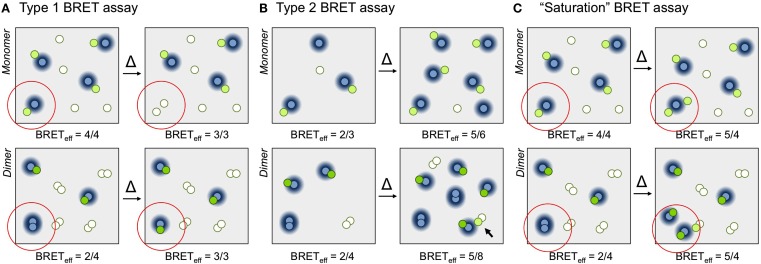Figure 1.
Principles of BRET assays. (A) In a type 1 BRET assay the acceptor/donor ratio is increased but surface density is kept constant. The increase in acceptor/donor ratio is obtained by exchanging a donor for an acceptor (the change is indicated within the red circle). For simplicity, BRETeff is defined here as the ratio of the numbers of fluorescent acceptors and luminescent donors. In the examples shown, for the monomer (top) BRETeff is unchanged (3/3 versus 4/4), whereas for the dimer (bottom) the ratio increases from 2/4 to 3/3 as the fraction of productive dimers increases. (B) In a type 2 BRET experiment, the acceptor/donor ratio is kept constant and surface density is varied, in this case by a factor of two. Due to the increase in monomer density (top) the likelihood of random collisions increases, and BRETeff increases from 2/3 to 5/6. For constitutive dimers (bottom), however, BRETeff is largely unchanged, increasing from 2/4 to 5/8, because the likelihood of dimerization doesn't change. Only random interactions of dimers (arrow) contribute to increases in BRETeff (in reality, of course, these contributions will be significantly smaller than the effects of dimerization). (C) In the “saturation” BRET assay, the acceptor/donor ratio is increased by keeping donor numbers constant and increasing the numbers of acceptors. In the examples shown, BRETeff for monomers (top) and dimers (bottom) both increase upon addition of one or two extra acceptors, respectively (from 4/4 to 5/4 for the monomer, and from 2/4 to 5/4 for the dimer). This is due to the increased random interactions of monomers, and increased formation and random interactions of dimers. We expect assays in which BRETeff always increases to be more easily misinterpreted than assays in which changes in BRETeff vary systematically with receptor stoichiometry.Fluorescing and non-fluorescing acceptor molecules are shown as green and white circles, respectively, and donors as blue circles. The BRET-permissible area surrounding donors is represented as a blue halo.

